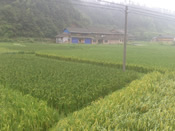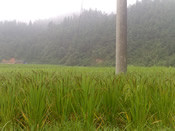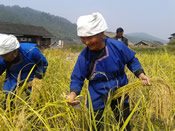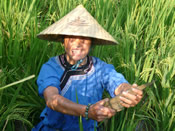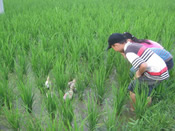
 |
| A farmer from Liufang Village of Liping County from Guizhou Province is harvesting a traditional crop of sticky rice. (Zhan Wei/PCD) |
By Li Qing (Programme Officer [Ecological Agriculture]), PCD
Modern agriculture has developed many new crop varieties with the help of science and technology. However, these new crop varieties come with several problems. This is because every new variety is introduced with a set of normalised or standardised cultivation technologies in which chemical fertilisers and pesticides are indispensable. Many new crop varieties have in fact proven to be poorly adapted to local environmental conditions, and are susceptible to pests and diseases. To guarantee their harvest, farmers have to apply large quantities of chemicals. Traditional crop varieties, on the other hand, have already adapted to the local climate and have developed resistance to pests and diseases. Even under adverse weather, a crop of traditional rice will not be wiped out entirely. Realising the comparative advantages of traditional crop varieties, some villages that were cultivating new crop varieties have now turned back to the old ones. An example is Liufang Village in Liping County, Guizhou Province.
Liufang villagers have grown hybrid rice since it was introduced many years ago. However, starting from 2003, one after another they have turned to growing traditional paddy rice again. Now, some farmers in neighbouring villages are doing the same. This is not just because of the concern for health and environmental hazards caused by artificial fertilisers and pesticides. There are also other reasons......
A way of farming that integrates with traditional culture
Liufang Village is inhabited by the Dong people, who traditionally practice rice-duck-fish farming. For Dong people, these three things are indispensable in everyday life as well as in festivals and celebrations. Not only does this traditional way of farming provide them with a rich source of food, it also conserves the ecological environment. The ducks and the fishes eat the weeds and pests in the paddies, while their manure fertilises the soil. It is a healthy ecological cycle and there is no need to apply chemicals. By contrast, hybrid rice is dependent on artificial fertilisers and pesticides, that contaminate the field. No fish or ducks can be raised in these paddy fields.
Traditional varieties of rice are more tasty
Liufang villagers think that the old varieties of rice have a better texture and taste better. They call it 'the aroma of rice'. Many villagers who work in the city bring their own rice with them because they are not used to the taste of the rice in the city. They are also worried that it is grown with chemicals, and is unsafe to eat.
Traditional crop varieties are adapted to local environment
The environment of a place does not only supply the inhabitants with food, it also dictates the specific varieties of crops that are suitable for growing there. In Liufang Village, some plots are located in areas with harsh conditions. Examples are the cold water paddies and the rusty water paddies [Note] up on the hills. The output of hybrid rice grown in these plots is less than that of old varieties. Farmers who own these plots continued to grow the old varieties even during the time when most villagers grew modern hybrid varieties.
Less human power and fewer inputs are required for traditional varieties of rice
When Liufang villagers returned to growing traditional varieties of rice and embarked on organic farming, the purpose was to earn money. A few years later, however, they realised that growing traditional varieties of rice would not bring in lots of cash. In some cases, not making a loss is already good enough. Today some villagers still sell the rice they grow but the priority is to meet their own needs. They only sell their rice when they have a surplus. Now villagers think that the most important thing is their own health. They know that when they are sick, not only do they suffer physically, they also have to spend money on doctors. But if they eat ecological rice, they do not fall sick so easily.
In recent years, many middle-aged villagers and young people have gone to work in the city, and there is a lack of human power in the village for farm work. Some farmers say that the output of hybrid rice is, generally speaking, higher than that of inbred rice. However, hybrid rice also demands more labour. They figure that for a few hundred catties more rice, they have to put in a lot more work in harvesting, processing and storing the rice. The price of hybrid rice is low and farmers have to buy seeds, chemical fertilisers and pesticides. So it is actually not profitable or cost-effective.
Liufang villagers now firmly believe in cultivating traditional varieties of rice. The ecological environment of the paddies has improved since they started to grow traditional varieties again. In the paddy fields, spiders can be seen capturing insects and the rice plants are suffering less disease or pest attack. The ducks and the fish help to weed and fertilise the paddy fields. Together with the fact that villagers have saved their own seeds, there is less need for cash input.
Over the last few years, when farmers of neighbouring villagers were laboriously applying pesticides, the farmers of Liufang Village were spending their leisure time singing. The neighbouring farmers thought that the Liufang villagers were indolent, and stealthily watched their way of farming. Now, some farmers in those neighbouring villages have also started to practice ecological farming. The Liufang Society of Organic Agriculture has provided them with seeds of traditional varieties of rice. With seeds come changes.
Note:
Cold water paddies: most of the cold water paddies are located on the highest and remotest parts of the mountain. The bigger ones are the size of a mattress while the small ones are so tiny that it is hard for any person to stand next to the plot. The water in these paddies is a few degrees lower than the other rice paddies and can only be used to grow varieties which are more cold-resistant.
Rusty water paddies: also known as coal rusty plots, coal water paddies, rust toxic paddies or reddish paddies. There is usually a layer of reddish brown oxidised iron on the surface of the water in these paddy fields. Sometimes rust-coloured sediment can be seen on the surface of the soil. This comes from the water leaking from coal mines in which sulphur and iron are found. They block the exchange of gas in the soil and the renewal of the environment and that affects the growth of rice and leads to lower production output.
Cold water paddies and rusty water paddies are considered poor fields.


